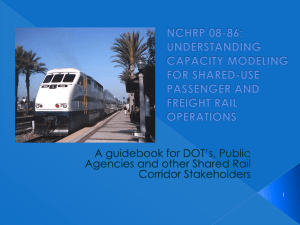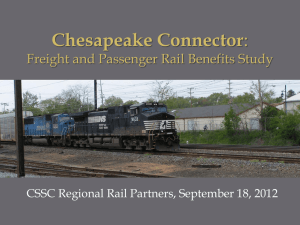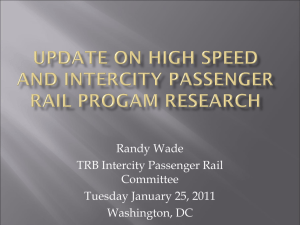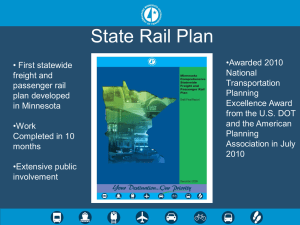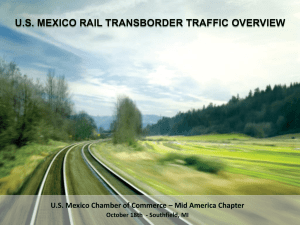Breakaway Session 1: Transport Infrastructure Part Three
advertisement
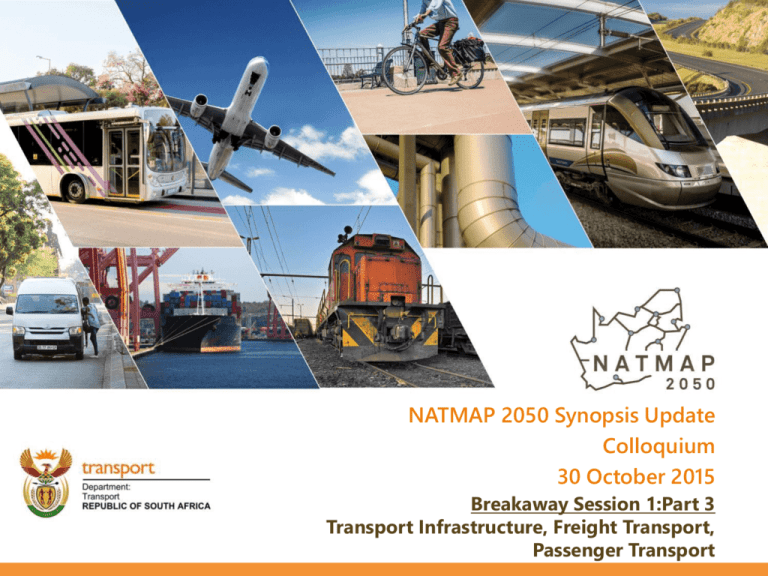
NATMAP 2050 Synopsis Update Colloquium 30 October 2015 Breakaway Session 1:Part 3 Transport Infrastructure, Freight Transport, Passenger Transport 2. Issues and Challenges: Passenger Transport • Not sufficiently customer focussed, poor levels of reliability, predictability comfort & safety • A lack of integration between passenger transport modes, despite the positive intentions behind the roll-out of Integrated Rapid Public Transport Networks (IRPTN); • Implementation of appropriate passenger transport modes associated with expected demand • Disjointed and inadequate provision of scholar transport • New low cost housing developments on the periphery of cities/towns add to urban sprawl resulting in long travel time and inefficient use of passenger transport • Lack of maintenance of current passenger transport facilities due to under investment, resulting in poor passenger facilities which in turn distracts from a pleasant customer experience • Government subsidies are not evenly distributed geographically • Lack of universally accessible passenger transport facilities and vehicles 2 2. Issues and Challenges: Freight Transport • Rail (12%) / Road (88%) modal split, uncompetitive, negative impact on road infrastructure • Road-Rail Competition: Road is major role-player in freight transport Rail market share declined due to operational policy constraints and road freight deregulation • Lack of adequately trained and competent personnel • Externalities associated with the increase in road freight operations • Overloading • Lack of freight information to support planning activities (freight database) 3 2. Issues and Challenges: Transport Infrastructure • Rail and Rural road infrastructure has been under-maintained - impacts on accessibility • Road: Lack of consolidated road information system Heavy vehicle overloading Deteriorating road conditions Poor road safety records Traffic congestion • Rail: Limited competitiveness with road Speed limitations for passenger trains Poor infrastructure and rolling stock condition and maintenance short-comings Capacity constraints on major corridors • Aviation: ACSA airports – good capacity • Maritime: Capacity constraints at ports – with intended upgrading • Pipelines: Operational constraints could result in liquid fuel shortages in near future 4 3. Priorities • Short Term (5-years): Modal shift and improved integration required Country-wide road, rail and port transport infrastructure improvements Road to rail shift in systematic manner • Medium to Long Term (5 - 15 & 15 - 30 years): Preparation of regulations on Universally Accessible Transport Develop a National TOD strategy and guidelines for Cities Urban densification National TDM Strategy and a Traffic Congestion Management Plan Investment in a Mobility Strategy and implementation in rural areas, providing access to transport opportunities National freight transport operations across all modes must work together to supply services to meet pit-to-port demands Planning in support of the Green Economy strategy 5 4. Interventions: Passenger Transport • The DoT and Department of Basic Education to develop a collaborative and integrated task team to investigate the Scholar Transport issue and decide on the most appropriate socio-economic solutions • Develop a modal technology choice framework to ensure the appropriate mode of passenger transport or other forms of transport are provided in relation to identified passenger demand • Development of an overarching Subsidy Policy; • An in-depth investigation, evaluation and economic feasibility into existing BRT systems, and the need to intervene in the future role of BRT systems in South Africa • Development of a NMT strategy and guideline for urban and rural transport systems • Implement Moloto Corridor Passenger Transport Services • Integrated ticketing system • Develop a financing and funding framework • Development and implementation of Universal Access guidelines 6 4. Interventions: Freight Transport • Adoption of a general policy principle to rebalance the road vs rail market share (road to rail strategy) • Implementation of a capacity-driven dedicated rail network strategy • Implement freight traffic regulatory measures • Integration of freight transport from ‘pit-to-port’ • Improved overloading control • Implementation of the following SIPs: SIP 1: Waterberg Mpumalanga-Richards Bay (KZN) Rail Link / Export Coal Line Expansion SIP2: Durban-Free State-Gauteng Logistics Corridor SIP 2: Cato Ridge Dry Port SIP 2: Durban Future Terminals: Development Plan SIP 3: Manganese Export Line • Completion of freight planning databank 7 4. Interventions: Transport Infrastructure • The development of a National Road-based Traffic Demand Management Plan for each corridor of national importance • Measures to improve efficiency at overloading control centres • Preventative Road Maintenance – to improve the lifecycle of roads at optimum levels, with a particular emphasis on rural provinces • Implement Moloto Corridor Passenger Transport Services to improve safety and mobility • Improving rail freight capacity ahead of demand • Implementation of PRASA’s corridor modernisation projects • Rail network signal upgrades in metro areas • New rolling stock, freight and passenger • High speed rail network expansion on a case by case basis • Passenger rail service expansion on cape gauge (standard gauge on case-bycase basis) • Implementation of SIP 1, 2 & 3 8 5. Questions / Discussions • Question 1:What do you consider the main issues in transport infrastructure and operations to be that NATMAP 2050 should aim to address? • Question 2: Do you broadly agree with the short, medium long term priorities? • Question 3: Which of the interventions proposed are most relevant and what else should be considered going forward? • Question 4: Of the proposed interventions, which are priority in the short to medium term? • Question 5: Does the proposed Implementation Framework provide a workable logical methodology for implementing interventions? 9 Final Thoughts and Thank you 10
